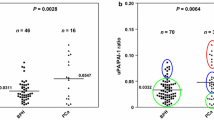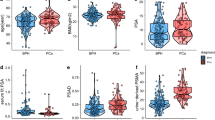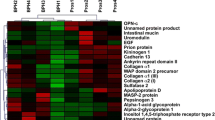Abstract
Background
Infections and inflammation in the prostate play a critical role in carcinogenesis, and S100A8 and S100A9 are key mediators in acute and chronic inflammation. Therefore, we investigated the differences of S100A8/A9 expression between prostate cancer (CaP) and benign prostatic hyperplasia (BPH) tissues, and we evaluated the possibilities of urinary nucleic acids of S100A8/A9 as diagnostic and prognostic markers.
Methods
Tissues from 132 CaP patients who underwent prostatectomy or transurethral resection and 90 BPH patients who underwent transurethral prostatectomy were assessed.sd In addition, S100A8 and S100A9 nucleic acid levels were measured in the urine of 283 CaP patients and 363 BPH controls.
Results
S100A8 and S100A9 mRNA levels were lower in CaP than BPH tissues (P < 0.001). S100A8 and S100A9 expression was increased in cancer tissues with poorer prognosis. In 69 specimens from prostatectomy patients, S100A8/A9 were the independent predictor of biochemical recurrence (hazard ratio 5.22, 95 % confidence interval 1.800–15.155, P = 0.002). Immunohistochemical staining revealed that BPH tissues stained more strongly for both S100A8 and S100A9 than CaP tissues (P < 0.001). S100A8 and S100A9 urinary nucleic acid levels were lower in CaP than in BPH (P = 0.001 and <0.001, respectively).
Conclusions
S100A8/A9 levels are lower in CaP than in BPH. Both were more highly expressed in patients with aggressive disease and shorter biochemical recurrence-free time. S100A8/A9 urinary cell-free nucleic acid levels correlated positively with expression levels obtained from tissue staining. Therefore, S100A8/A9 measurement in tissues and urine may have diagnostic and prognostic value in CaP.


Similar content being viewed by others
References
Jemal A, Siegel R, Xu J, Ward E. Cancer statistics, 2010. CA Cancer J Clin. 2010;60:277–300.
Jung KW, Won YJ, Park S, et al. Cancer statistics in Korea: incidence, mortality and survival in 2005. J Korean Med Sci. 2009;24:995–1003.
Kim D, Choi D, Lim JH, et al. Changes in prostate cancer aggressiveness over a 12-year period in Korea. Korean J Urol. 2012;53:680–5.
Zimmer DB, Cornwall EH, Landar A, Song W. The S100 protein family: history, function, and expression. Brain Res Bull. 1995;37:417–29.
Donato R. S100: a multigenic family of calcium-modulated proteins of the EF-hand type with intracellular and extracellular functional roles. Int J Biochem Cell Biol. 2001;33:637–68.
Santamaria-Kisiel L, Rintala-Dempsey AC, Shaw GS. Calcium-dependent and -independent interactions of the S100 protein family. Biochem J. 2006;396:201–14.
Ehrchen JM, Sunderkotter C, Foell D, Vogl T, Roth J. The endogenous Toll-like receptor 4 agonist S100A8/S100A9 (calprotectin) as innate amplifier of infection, autoimmunity, and cancer. J Leukoc Biol. 2009;86:557–66.
Nemeth J, Stein I, Haag D, et al. S100A8 and S100A9 are novel nuclear factor kappa B target genes during malignant progression of murine and human liver carcinogenesis. Hepatology. 2009;50:1251–62.
Grebhardt S, Muller-Decker K, Bestvater F, Hershfinkel M, Mayer D. Impact of S100A8/A9 expression on prostate cancer progression in vitro and in vivo. J Cell Physiol. 2014;229:661–1.
Hermani A, Hess J, De Servi B, et al. Calcium-binding proteins S100A8 and S100A9 as novel diagnostic markers in human prostate cancer. Clin Cancer Res. 2005;11:5146–52.
Grebhardt S, Veltkamp C, Strobel P, Mayer D. Hypoxia and HIF-1 increase S100A8 and S100A9 expression in prostate cancer. Int J Cancer. 2012;131:2785–94.
Tidehag V, Hammarsten P, Egevad L, et al. High density of S100A9 positive inflammatory cells in prostate cancer stroma is associated with poor outcome. Eur J Cancer. 2014;50:1829–1835.
Gahan PB, Swaminathan R. Circulating nucleic acids in plasma and serum. Recent developments. Ann N Y Acad Sci. 2008;1137:1–6.
Casadio V, Calistri D, Salvi S, et al. Urine cell-free DNA integrity as a marker for early prostate cancer diagnosis: a pilot study. Biomed Res Int. 2013;2013:270457.
De Maio G, Rengucci C, Zoli W, Calistri D. Circulating and stool nucleic acid analysis for colorectal cancer diagnosis. World J Gastroenterol. 2014;20:957–67.
Casadio V, Calistri D, Tebaldi M, et al. Urine cell-free DNA integrity as a marker for early bladder cancer diagnosis: preliminary data. Urol Oncol. 2013;31:1744–50.
Jahr S, Hentze H, Englisch S, et al. DNA fragments in the blood plasma of cancer patients: quantitations and evidence for their origin from apoptotic and necrotic cells. Cancer Res. 2001;61:1659–65.
Kanduc D, Mittelman A, Serpico R, et al. Cell death: apoptosis versus necrosis (review). Int J Oncol. 2002;21:165–70.
Acknowledgment
The specimens for this study were provided by the Chungbuk National University Hospital, a member of the National Biobank of Korea, which is supported by the Ministry of Health, Welfare and Family Affairs. All samples were obtained with informed consent under institutional review board–approved protocols (approval GR2010-12-010). This article was supported by the Basic Science Research Program through the National Research Foundation of Korea (NRF) funded by the Ministry of Education, Science and Technology (2012R1A1A4A01008753 and 2008-0062611), and by a Grant from the Next Generation BioGreen 21 Program (PJ0081952011), Rural Development Administration, Republic of Korea.
Disclosure
The authors declare no conflict of interest.
Author information
Authors and Affiliations
Corresponding author
Additional information
Seok Joong Yun and Chunri Yan contributed equally to this article, and both should be considered first author.
Electronic Supplementary Material
Below is the link to the electronic supplementary material.
Rights and permissions
About this article
Cite this article
Yun, S.J., Yan, C., Jeong, P. et al. Comparison of mRNA, Protein, and Urinary Nucleic Acid Levels of S100A8 and S100A9 between Prostate Cancer and BPH. Ann Surg Oncol 22, 2439–2445 (2015). https://doi.org/10.1245/s10434-014-4194-4
Received:
Published:
Issue Date:
DOI: https://doi.org/10.1245/s10434-014-4194-4




